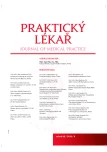Diagnostics and treatment of patients with visceral ischaemia
Authors:
L. Kubíček; R. Staffa; T. Novotný
Authors‘ workplace:
Přednosta: prof. MUDr. Robert Staffa, Ph. D.
; Centrum cévních onemocnění
; II. chirurgická klinika
; Fakultní nemocnice u sv. Anny v Brně
; Lékařská fakulta
; Masarykova univerzita, Brno
Published in:
Prakt. Lék. 2019; 99(6): 253-257
Category:
Various Specialization
Overview
Visceral ischaemia is a pathological condition characterized by arterial malfunction in splanchnic circulation leading to an ischaemia of organs in abdominal cavity. It is a relatively rare condition, but it’s consequences can be fatal. There are two forms of visceral ischaemia: acute visceral ischaemia, what is a kind of acute abdomen (also called vascular ileus) and chronic visceral ischaemia caused by atherosclerotic lesions of abdominal aorta and splanchnic branches. The most typical sign of both forms of visceral ischaemia is an abdominal pain either severe acute pain with catastrophic course or progressively developing pain accompanied by alimentary disorder and unintentional weight loss. Differential diagnostics in both forms based only on clinical symptoms is usually difficult and can easily lead to a wrong diagnosis and holdup of necessary revascularization procedure. Ultrasound examination has a lower sensitivity and angiographic examination is usually needed to acquire a proper diagnosis. In the case of acute ischaemia patient’s life is immediately threatened due to a high risk of intestinal necroses (with mortality between 60 and 100%), this condition requires urgent surgical intervention in form of thrombectomy or bypass surgery, in most of the cases accompanied with resection of necrotic part of the intestine. The leading symptom in the case of chronic ischemia is abdominal pain after eating and unintentional weight loss. After a proper diagnosis is set, the best course of treatment is an endovascular procedure in form of percutaneous angioplasty or stent implantation. If an atherosclerotic lesion is too severe, surgical bypass or arterial patch should be considered. Both approaches have a comparable outcome regarding a pain relief, surgical methods have a higher rate of complications but also a better long-term patency. Because of a high severity of this conditions we should always consider a possibility of visceral ischaemia in any case of either acute or chronic abdominal pain.
Keywords:
visceral ischaemia – mesenterial ischaemia – abdominal pain diagnostics – intestinal infarction – vascular ileus
Sources
1. Winter TC 3rd, Nghiem HV, Schmiedl UP, Freeny PC. CT angiography of the visceral vessels. Semin Ultrasound CT MR 1996; 17(4): 339–351.
2. Lawson RM. Mesenteric ischemia. Crit Care Nurs Clin North Am 2018; 30(1): 29–39.
3. Adelson AB. CT and MR angiography: comprehensive vascular assessment. AJR 2009; 192(5): W269–W269.
4. Schoots IG1, Koffeman GI, Legemate DA, et al. Systematic review of survival after acute mesenteric ischaernia according to disease aetiology. Br J Surg 2004; 91(1): 17–27.
5. Mesina C, Vasile I, Pasalega M, et al. Acute mesenteric ischemia. Chirurgia 2008; 103(4): 385–394.
6. Boley SJ, Brandt LJ, Veith FJ. Ischemic disorders of the intestines. Curr Probl Surg 1978; 15(4): 1–85.
7. Stoney RJ, Wylie EJ. Recognition and surgical management of visceral ischemic syndromes. Ann Surg 1966; 164(4): 714–722.
8. Evennett NJ, Petrov MS, Mittal A, Windsor JA. Systematic review and pooled estimates for the diagnostic accuracy of serological markers for intestinal ischemia. World J Surg 2009; 33(7): 1374–1383.
9. Smerud MJ, Johnson CD, Stephens DH. Diagnosis of bowel infarction – a comparison of plain films and CT scans. AJR 1990; 154(1): 99–103.
10. Alpern MB, Glazer GM, Francis IR. Ischemic or infarcted bowel – CT findings. Radiology [online] 1988; 166(1 Pt1): 149–152.
11. Bala M, Kashuk J, Moore EE. Acute mesenteric ischemia: guidelines of the World Society of Emergency Surgery. World J Emerg Surg 2017; 12: 38. Dostupné na: doi: 10.1186/s13017-017-0150-5 [cit. 2019-09-17].
12. Meng X, Liu L, Jiang H. Indications and procedures for second-look surgery in acute mesenteric ischemia. Surg Today 2010; 40(8): 700–705.
13. Schaefer PJ, Schaefer FKW, Mueller–Huelsbeck S, Jahnke T. Chronic mesenteric ischemia: stenting of mesenteric arteries. Abdom Imaging 2007; 32(3): 304–309.
14. Anonymous. American Gastroenterological Association medical position statement: Guidelines on intestinal ischemia. Gastroenterology 2000; 118(5): 951–953.
15. Geroulakos G, Robless PA, Smead WL. Visceral ischemic syndromes. In: Davies AH, Brophy CM. (eds.). Vascular Surgery. Springer Specialist Surgery Series. London: Springer 2006; 231–236.
16. Hallisey MJ, Deschaine J, Illescas FF, et al. Angioplasty for the treatment of visceral ischemia. J Vasc Interv Radiol 1995; 6(5): 785–791.
Labels
General practitioner for children and adolescents General practitioner for adultsArticle was published in
General Practitioner

2019 Issue 6
Most read in this issue
- Diagnostics and treatment of patients with visceral ischaemia
- Konsenzus používání antibiotik: fluorochinolony*
- Screening methods for the detection of obstructive sleep apnoea syndrome
- Health risks of phytotoxins in "mad" honey
